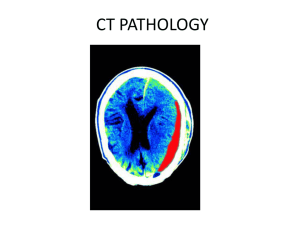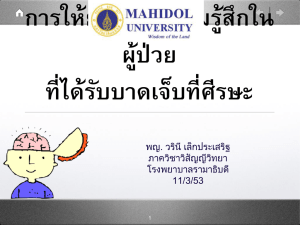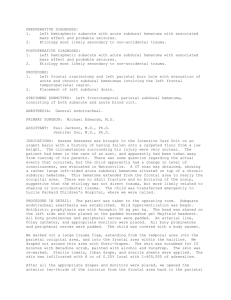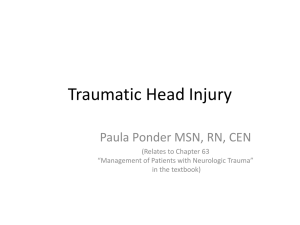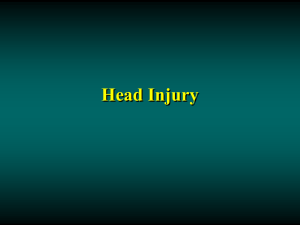Types of Injury - camem
advertisement
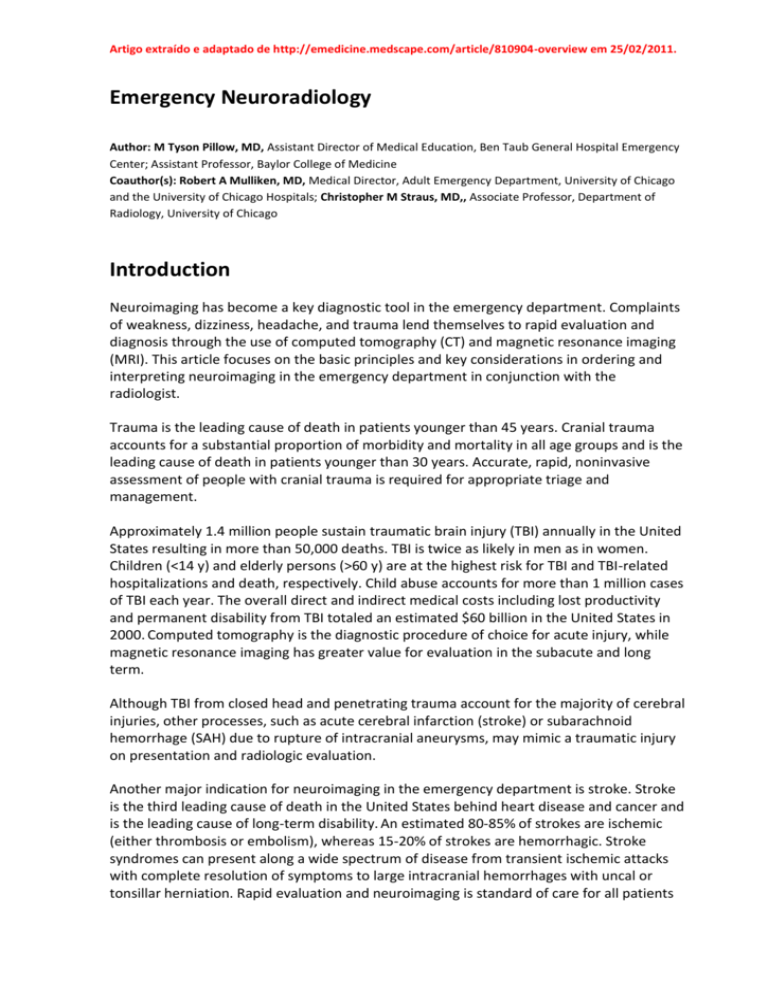
Artigo extraído e adaptado de http://emedicine.medscape.com/article/810904-overview em 25/02/2011. Emergency Neuroradiology Author: M Tyson Pillow, MD, Assistant Director of Medical Education, Ben Taub General Hospital Emergency Center; Assistant Professor, Baylor College of Medicine Coauthor(s): Robert A Mulliken, MD, Medical Director, Adult Emergency Department, University of Chicago and the University of Chicago Hospitals; Christopher M Straus, MD,, Associate Professor, Department of Radiology, University of Chicago Introduction Neuroimaging has become a key diagnostic tool in the emergency department. Complaints of weakness, dizziness, headache, and trauma lend themselves to rapid evaluation and diagnosis through the use of computed tomography (CT) and magnetic resonance imaging (MRI). This article focuses on the basic principles and key considerations in ordering and interpreting neuroimaging in the emergency department in conjunction with the radiologist. Trauma is the leading cause of death in patients younger than 45 years. Cranial trauma accounts for a substantial proportion of morbidity and mortality in all age groups and is the leading cause of death in patients younger than 30 years. Accurate, rapid, noninvasive assessment of people with cranial trauma is required for appropriate triage and management. Approximately 1.4 million people sustain traumatic brain injury (TBI) annually in the United States resulting in more than 50,000 deaths. TBI is twice as likely in men as in women. Children (<14 y) and elderly persons (>60 y) are at the highest risk for TBI and TBI-related hospitalizations and death, respectively. Child abuse accounts for more than 1 million cases of TBI each year. The overall direct and indirect medical costs including lost productivity and permanent disability from TBI totaled an estimated $60 billion in the United States in 2000. Computed tomography is the diagnostic procedure of choice for acute injury, while magnetic resonance imaging has greater value for evaluation in the subacute and long term. Although TBI from closed head and penetrating trauma account for the majority of cerebral injuries, other processes, such as acute cerebral infarction (stroke) or subarachnoid hemorrhage (SAH) due to rupture of intracranial aneurysms, may mimic a traumatic injury on presentation and radiologic evaluation. Another major indication for neuroimaging in the emergency department is stroke. Stroke is the third leading cause of death in the United States behind heart disease and cancer and is the leading cause of long-term disability. An estimated 80-85% of strokes are ischemic (either thrombosis or embolism), whereas 15-20% of strokes are hemorrhagic. Stroke syndromes can present along a wide spectrum of disease from transient ischemic attacks with complete resolution of symptoms to large intracranial hemorrhages with uncal or tonsillar herniation. Rapid evaluation and neuroimaging is standard of care for all patients Artigo extraído e adaptado de http://emedicine.medscape.com/article/810904-overview em 25/02/2011. with suspected strokes and guides the decision to administer thrombolytics, intra-arterial intervention, or medical management. Also see Stroke, Ischemic and Stroke, Hemorrhagic. Clinical History Age, comorbidities Head trauma Motor vehicle collision Fall/jump from height Assault Penetrating injury Loss of consciousness Headache Changes in vision Changes in strength or sensation Coordination or balance problems Loss of executive function or cognition Seizure Coagulation disorders or therapy Intoxication; history of substance abuse Previous neurosurgery Physical Altered mental status; unresponsiveness; deficits in Glasgow Coma Scale Amnesia Depressed skull fracture Penetrating head injury Focal neurologic deficit such as weakness, paresthesia, gait abnormality, aphasia, cranial nerve abnormality Abnormal behavior Hypertension Acute pupillary asymmetry or changes in reactivity Intoxication Differential Diagnoses Acute stroke (embolic/hemorrhagic) Cardiac syncope Hypertensive crisis/hemorrhage Intracranial hemorrhage Rupture of arteriovenous malformation/aneurysms Intracranial mass Artigo extraído e adaptado de http://emedicine.medscape.com/article/810904-overview em 25/02/2011. Seizure; postictal state Meningitis/encephalitis/systemic infection Toxic/metabolic disorders Complex migraine Diagnostic Workup Computed tomography scanning CT is the imaging procedure of choice in evaluation of acutely injured patients or patients with acute neurologic deficit. Quick, easy, reliable, and routinely available, CT is valuable in making a firm diagnosis as well as in excluding alternative diagnoses or the sequelae of other pathology, even in uncooperative patients. Patient monitoring is simple and safe, and CT is compatible with patient stabilization devices. Identification and localization of fractures and bony/metallic fragments are easily achieved, as is the assessment for acute hemorrhage and mass effect. Primary indications for CT include acute head trauma, suspected acute intracranial hemorrhage, mental status changes, headache, acute neurologic deficits, suspected intracranial infection, suspected hydrocephalus, brain herniation, and suspected mass tumor. In cases in which MRI is primarily indicated but unavailable, contraindicated, or delayed, CT may also be used. In cases of trauma, CT is recommended in all patients with severe traumatic brain injury (TBI) (Glasgow Coma Scale [GCS] <8) and moderate TBI (GCS 9-12). In mild TBI (GCS >13), CT is more controversial. Recent studies suggest that high-risk features include GCS less than 15 two hours after the injury, any signs of basal skull fracture (hemotympanum, raccoon eyes, Battle's sign), suspected open or depressed skull fracture, more than 2 episodes of vomiting, or age older than 65 years. Moderate-risk features include dangerous mechanism (fall >3 ft, pedestrian struck by automobile), and amnesia longer than 30 minutes prior to event. However, many providers still recommend that patients who have history of neurosurgery, coagulopathy, and loss of consciousness should also undergo CT. Elderly patients also present a greater risk of TBI and significant intracranial pathology after trauma and are more likely to present with occult injuries. The routine cranial CT protocol should at minimum include contiguous sections, 5-10 mm thick, from the skull base through the vertex (thinner at base, thicker at vertex) without contrast. Contrast infusion is indicated in the search for mass lesions and vascular pathology (including carotid or vertebral dissection, basilar syndromes), and in patients with a history of human immunodeficiency virus infection and neurological examination abnormalities. Artigo extraído e adaptado de http://emedicine.medscape.com/article/810904-overview em 25/02/2011. If CT findings are normal, stable patients who experience mild TBI can be discharged safely after a period of clinical observation. In those who experience moderate or severe TBI, a negative CT does not rule out the delayed development of hemorrhage. These patients and patients with a positive CT should undergo a follow-up scan within 24 hours or earlier if symptoms change and/or deteriorate. Magnetic resource imaging MRI is valuable in identifying subtle abnormalities on initial and subacute evaluation and in dating injury. MRI is generally better than conventional CT at detecting abnormalities in and progression of posterior fossa and brainstem injuries, child abuse, cortical contusions, and shearing injuries.8 However, MRI is not as readily available as CT. Appropriate patient monitoring is difficult and unreliable due to strong magnetic fields, time-varying magnetic gradients, and restricted access to the patient. Many newer-generation MRI machines have improved these conditions. Additionally, patients who have cardiac pacemakers, ferromagnetic intracranial aneurysm clips, and certain ferromagnetic foreign bodies or electronic devices or implants should not undergo MRI. Primary indications for MRI include evaluation of seizures, cranial nerve dysfunction, diplopia, ataxia, acute and chronic neurologic deficits, suspicion of neurodegenerative disease, primary and secondary neoplasm, aneurysm, vasculitis, encephalitis, headache, mental status change, hydrocephalus, ischemic disease and infarction, suspected pituitary dysfunction, inflammation or infection of the brain or meninges or their complications, demyelination and dysmyelination disorders, vascular malformations, and arterial or venous/dural sinus abnormalities. Patients who have cardiac pacemakers, ferromagnetic intracranial aneurysm clips, and certain ferromagnetic foreign bodies or electronic devices or implants should not undergo MRI. The routine MRI protocol varies considerably based on strength of the unit's field, machine capabilities, and suspected diagnosis. Most centers perform sagittal T1-weighted and axial T1- and T2-weighted sequences of the brain routinely, with the addition of specific additional sequences depending on the clinical indications. T2-weighted gradient echo sequences are more sensitive for subacute/chronic parenchymal hemorrhage/shearing injuries, while fluid-attenuated inversion recovery (FLAIR) sequences have been shown to be more sensitive for subtle subarachnoid blood. Magnetic resonance angiography and venography, diffusion and perfusion imaging, and spectroscopy may all be valuable in selected circumstances. MRI with diffusion-weighted imaging (DWI) has become more routinely used in the detection of acute stroke because of its improved sensitivity, negative predictive value, and accuracy compared with CT and conventional MRI. MRI with DWI has also been helpful in the detection of the early stages of brain infection such as meningitis, toxoplasmosis, herpes simplex, and West Nile virus. Types of Injury Epidural hematoma Artigo extraído e adaptado de http://emedicine.medscape.com/article/810904-overview em 25/02/2011. The dura mater is composed of 2 layers closely invested with each other: the visceral or meningeal layer, which lines the intracranial space, and the parietal layer, which functions as the periosteum fused to the calvarium. The dura, therefore, adheres tightly to the cranial sutures. A skull fracture that crosses an arterial branch may bleed into the closed space between the calvarium and the periosteal layer, forming a homogeneously high-density lens-shaped or biconvex collection, termed epidural hematoma (EDH) (see the images below). Because of the transmitted arterial pressure, epidural hematoma tends to continue to enlarge, with resultant increasing mass effect. This explains the classic presentation associated with epidural hematoma of an initial loss of consciousness followed by a lucid interval with subsequent neurologic deterioration. However, a lucid interval is present in only 40% of cases and is not pathognomonic for epidural hematoma. Linear skull fracture - Emergency neuroradiology. Axial CT scan, bone window, shows linear skull fracture through the temporal squamosa (arrow). Artigo extraído e adaptado de http://emedicine.medscape.com/article/810904-overview em 25/02/2011. Epidural hematoma - Emergency neuroradiology. Axial CT scan, brain window, at the same level as the previous image, shows left frontal epidural hematoma (arrow) displacing the falx and brain posteriorly and to the right. Prognosis is generally good for acute hematomas in conscious patients who undergo immediate surgical correction. Mortality is approximately 5%. Subdural hematoma The subdural space is bound externally by the meningeal layer of the dura and internally by the arachnoid mater. Hematomas are confined by the reflected dura of the tentorium and falx but easily spread into the intervening potential space to form crescentic or convexout/concave-in collections called subdural hematomas (SDHs) (see the image below). Abrupt acceleration/deceleration injury tearing bridging cortical veins that traverse this space accounts for most subdural hematomas. This is more likely to occur in elderly patients and other patients with atrophy, where the subdural space is enlarged. Artigo extraído e adaptado de http://emedicine.medscape.com/article/810904-overview em 25/02/2011. Subdural hematoma - Emergency neuroradiology. Axial CT scan though the level of the lateral ventricles shows right-sided subdural hematoma along the convexity (red arrow) and falx (green arrow), with severe midline shift from right to left. Acute hemorrhage is dense on CT with brain windowing, assuming normal hematocrit. As blood ages, it becomes less dense, so that by about 7-10 days, it approximates the same density as adjacent brain tissue. At this stage, the isodense subdural hematoma (see the first image below) is described. Detection requires careful inspection of the subdural or intermediate windowing, which usually shows inward displacement of the cortical gray/white matter junction and mass effect, otherwise unexplained by the imaging findings. Intravenous contrast has been shown to increase detection with enhancement of the bridging veins possibly defining the collection (see the second image below). Homogeneous density within a subdural collection generally represents interval hemorrhage into a preexisting chronic subdural hematoma (SDH). The mortality rate for acute subdural hematoma is 37-57%. Most patients with decreased sensorium have poor outcomes, likely secondary to associated diffuse cerebral brain swelling. In these cases, immediate surgical evacuation does not always improve outcome. Ischemic stroke Artigo extraído e adaptado de http://emedicine.medscape.com/article/810904-overview em 25/02/2011. Patients with ischemic stroke in the emergency setting may present a different course for decision-making. Ischemic stroke secondary to trauma is either due to vertebral artery dissection or carotid artery dissection. Risk factors for these injuries include penetrating trauma, C1-3 fractures, chiropractor manipulation, and possibly bruising to the neck from seatbelts. In ischemic stroke, acute (12-48 h) occlusion of one or more large vessels results in focal, wedge-shaped peripheral areas of loss of grey/white matter differentiation involving the cortex and contiguous white matter, or simply as a focal mass effect (see the image below). Anoxia or hypotension results in diffuse loss of gyral/cortical markings and diffuse mass effect. MCA stroke - Emergency neuroradiology. Axial CT scan shows a peripheral wedge-shaped area of decreased density (arrow) involving the right caudate head and lentiform nuclei, insula, and frontal and temporal lobes, consistent with a subacute right proximal middle cerebral artery occlusion and subsequent cerebrovascular infarction. A mild mass effect and shift of the midline to the left is shown.
